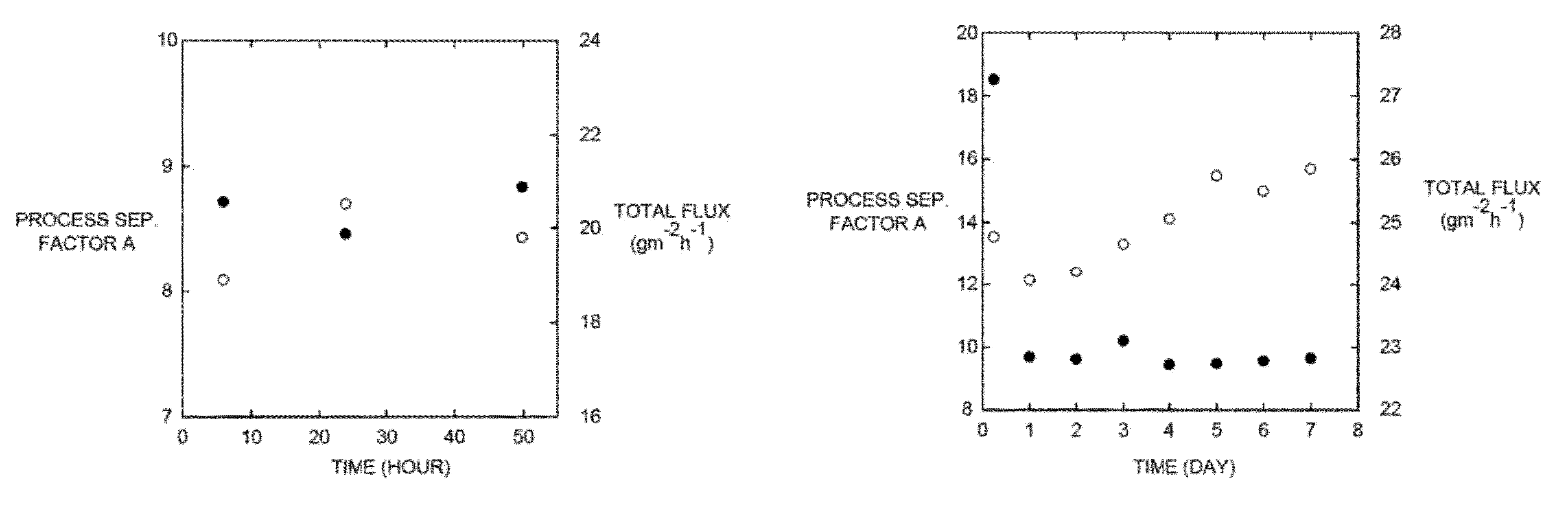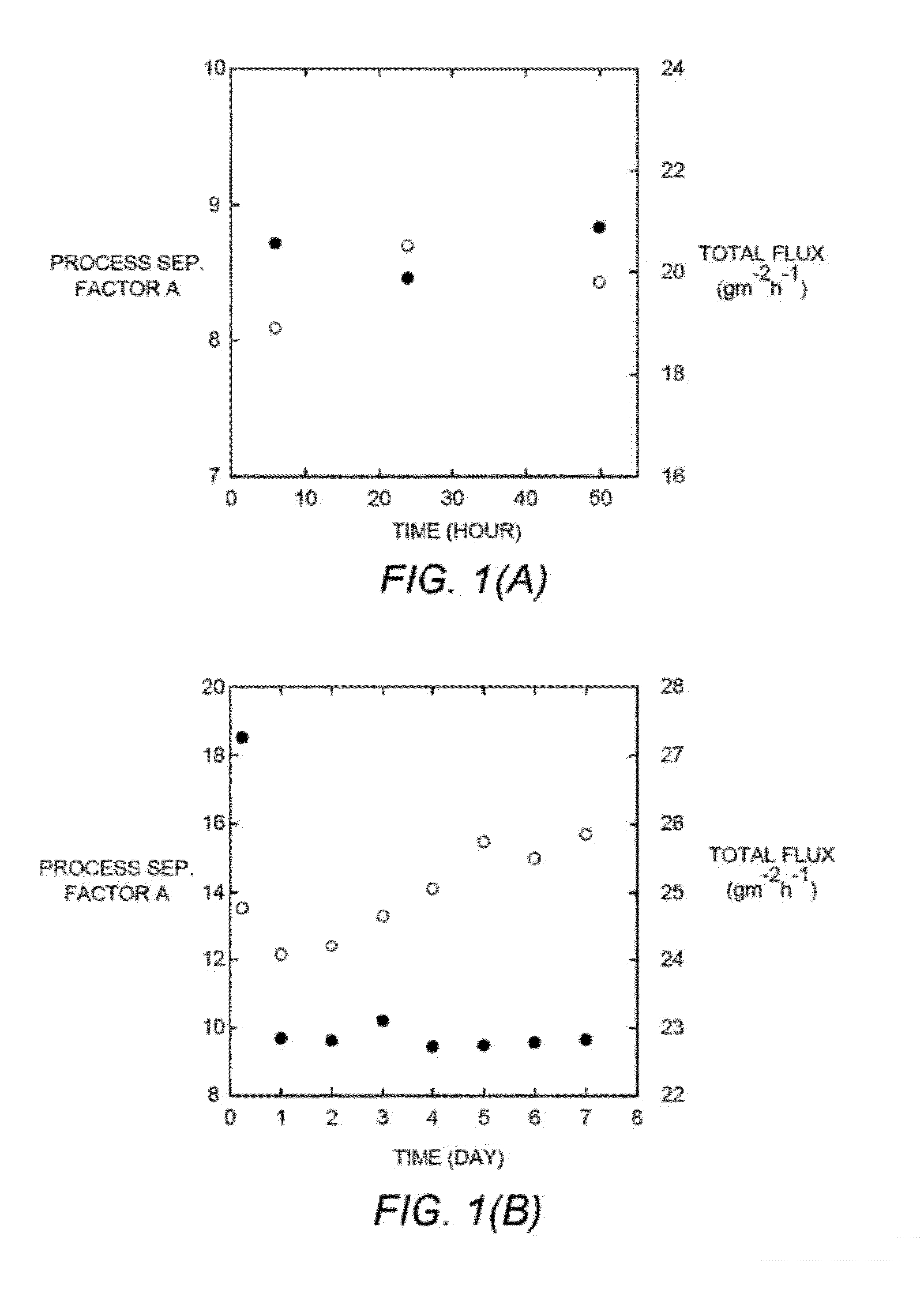Nanostructured polymer membranes for selective alcohol transport
a technology of nanostructured polymer membranes and alcohol, which is applied in the preparation of oxygen-containing compounds, hydroxy compounds, purification/separation of oxygen compounds, etc., can solve the problems of unsatisfactory performance of alcohol-selective membrane materials, the inability to compete commercially with distillation, and the inability to find alcohol-selective membrane materials that perform well enough to achieve the effect of commercialization
- Summary
- Abstract
- Description
- Claims
- Application Information
AI Technical Summary
Benefits of technology
Problems solved by technology
Method used
Image
Examples
example 1
Synthesis of Polycyclooctene (PCOE)-Polydimethylsiloxane (PDMS) Graft Copolymers
[0126]PCOE-PDMS graft copolymers (PCOE-graft-PDMS) where the backbone is PCOE and the pendant chains are PDMS have been synthesized as an alcohol-selective membrane material. PCOE-graft-PDMS may be synthesized through a combination of ring opening polymerization and ring opening metathesis polymerization reactions. The number of PDMS chains and the PDMS chain length are readily tuned by manipulation of the reaction stoichiometry. The resultant copolymers may be cast into membranes of desired thickness. PDMS-X, where the X group is reactive to a metathesis catalyst, was synthesized via anionic polymerization of hexamethylcyclotrisiloxane followed by an end capping reaction. An exemplary synthesis of norbornene substituted with at least one dialkylsiloxane group is shown in Scheme 1. The PDMS anions were capped with norbornenylethyldimethylchlorosilane.
[0127]
[0128]Three PDMS-N polymers of varied molecular ...
example 2
Selective Alcohol Separation from Aqueous Solution Using Polycyclooctene (PCOE)-Polydimethylsiloxane (PDMS) Graft Copolymers as the Membrane
[0133]Material
[0134]Ethanol / water pervaporation experiments were conducted on membranes made from PCOE-PDMS graft copolymers. The feed aqueous solution contained approximately 8 wt % ethanol, and ethanol concentrations in permeates were analyzed by NMR experiments. The process separation factor α and total flux were plotted against permeation time (FIGS. 1a-1c). At 43° C., for each membrane, an equilibrium state was reached after roughly 6 hours. As the length of PDMS chains increased, ethanol selectivity increased accordingly and remained constant when the Mn value of the PDMS chains reached 2.4 kg mol−1. PCOE-g-PDMS—2 was measured at 43° C. continuously for one week, and no decay in selectivity or flux was observed. At 43° C., PCOE-g-PDMS—2 exhibited high ethanol selectivity (>18) in the first 6 h, while this phenomenon was not observed in the...
example 3
Synthesis of Polycyclooctene (PCOE)-Polydimethylsiloxane (PDMS) Triblock Copolymers (Also Referred to as “DCD” Copolymers Herein)
[0136]Triblock copolymers containing PDMS and PCOE have been prepared. 1,2-bis (bromoisobutyryloxy)-2-butene was prepared as described in literature (ref. 3). PDMS-Y, where Y is a functional group, may be polymerized with radical initiators. Herein, methacrylate-terminated PDMS (PDMS-MA) is commercially available. Ring opening metathesis polymerization of a cyclic monomer like COE in the presence of a chain transfer agent (1,2-bis (bromoisobutyryloxy)-2-butene) yielded telechelic polycyclooctene (Br—PCOE-Br). In a subsequent atom transfer radical polymerization (ATRP) of PDMA-MA using Br—PCOE-Br as a macro-initiator, a triblock copolymer containing two P(PDMS-MA) end blocks was produced (Scheme 2). Unlike most linear triblock copolymers, the middle block is linear while the end blocks are PDMS brushes.
[0137]
[0138]A series of PCOEBr (6-50 kg mol−1) have bee...
PUM
| Property | Measurement | Unit |
|---|---|---|
| wt % | aaaaa | aaaaa |
| domain size | aaaaa | aaaaa |
| wt % | aaaaa | aaaaa |
Abstract
Description
Claims
Application Information
 Login to View More
Login to View More - R&D
- Intellectual Property
- Life Sciences
- Materials
- Tech Scout
- Unparalleled Data Quality
- Higher Quality Content
- 60% Fewer Hallucinations
Browse by: Latest US Patents, China's latest patents, Technical Efficacy Thesaurus, Application Domain, Technology Topic, Popular Technical Reports.
© 2025 PatSnap. All rights reserved.Legal|Privacy policy|Modern Slavery Act Transparency Statement|Sitemap|About US| Contact US: help@patsnap.com



